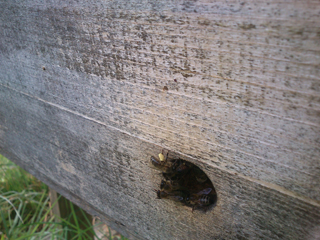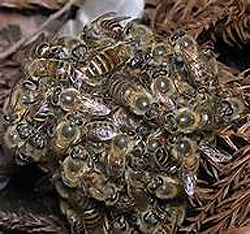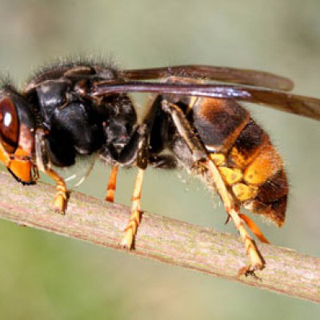 The weather over the past two weeks has been a lot warmer when the sun was shining, but out of the sun’s rays the easterly and north easterly winds dropped the temperatures considerably. We had family visiting over the Easter week, with a great-nephew of 4 years of age to entertain, and then we went off to North Wales to visit two of our grandchildren, 8 and 4 years of age, so we were somewhat tired after the Easter “holidays”! However, running around after young children in the sun, we kept very warm – even on the North Wales coast – though the cold winds before and since have meant that opening up a bee hive and pulling out the combs to examine them is not something that I have done yet – nor would I have done if I had been at home last week.
The weather over the past two weeks has been a lot warmer when the sun was shining, but out of the sun’s rays the easterly and north easterly winds dropped the temperatures considerably. We had family visiting over the Easter week, with a great-nephew of 4 years of age to entertain, and then we went off to North Wales to visit two of our grandchildren, 8 and 4 years of age, so we were somewhat tired after the Easter “holidays”! However, running around after young children in the sun, we kept very warm – even on the North Wales coast – though the cold winds before and since have meant that opening up a bee hive and pulling out the combs to examine them is not something that I have done yet – nor would I have done if I had been at home last week.
The reason for this is as the result of an experience I had many years ago, when I was lulled into a false sense of security one day in late February after we had had a few days of very warm weather. Because the bees had been flying and bringing in pollen in one particular hive, I knew they were fine, so chose not to do a brood comb examination.
 Instead, I took the opportunity to change the floor and give the bees a clean one (during the winter the bees often can’t fly from the hive with rubbish such as wax cappings taken from the food cells and dead bees lying on the floor. We can often help them by doing their housework for them, allowing them to concentrate on pollen and nectar collection instead). I lifted the brood box off its floor and placed it carefully to one side, balanced across the upturned roof, exchanged the floor for a clean one and replaced the brood box on the clean floor (the old one was taken away for cleaning and sterilising).
Instead, I took the opportunity to change the floor and give the bees a clean one (during the winter the bees often can’t fly from the hive with rubbish such as wax cappings taken from the food cells and dead bees lying on the floor. We can often help them by doing their housework for them, allowing them to concentrate on pollen and nectar collection instead). I lifted the brood box off its floor and placed it carefully to one side, balanced across the upturned roof, exchanged the floor for a clean one and replaced the brood box on the clean floor (the old one was taken away for cleaning and sterilising).
A few weeks later I noticed very little flying from this hive and no pollen was being brought home, so as the weather had improved and was warm enough, I went into the brood box to check things over. To cut a long story short, they were queenless, with no brood and very little surplus stores, whereas when I changed the floor they were obviously queen-right. What had happened? Why had the queen gone missing?
Basically, I put it down to the fact that the bees had been undisturbed all winter, when suddenly, at the first sign of fine weather, their home was being lifted into the air and moved to one side and they were being “attacked” (as they saw it) by a predator of some sort. They therefore rushed to protect the queen by surrounding her and unfortunately surrounded her too tightly, thereby suffocating her, in what is known as “queen balling”.
 This also sometimes happens when introducing new queens to a queen-less colony, even when precautions are taken, but in this instance it was not an act of aggression but one of love, too much of which resulted in the death of their queen. I therefore no longer change my hive floors in February or March (when the books say you should do it), nor necessarily even April. The bees can manage for a little while longer with a dirty floor, so I wait until the weather is consistent and the bees have been flying for a few weeks rather than a few days before I change their floors, since when I have not had the problem.
This also sometimes happens when introducing new queens to a queen-less colony, even when precautions are taken, but in this instance it was not an act of aggression but one of love, too much of which resulted in the death of their queen. I therefore no longer change my hive floors in February or March (when the books say you should do it), nor necessarily even April. The bees can manage for a little while longer with a dirty floor, so I wait until the weather is consistent and the bees have been flying for a few weeks rather than a few days before I change their floors, since when I have not had the problem.
All my hives have been bringing in pollen and nectar over the past month, so I have basically left them alone, apart from putting a super on every colony so they have somewhere to store any excess nectar before converting it to honey. In Tregony and Portscatho, where rape is growing within flying distance of the hives, this is imperative, otherwise the voluminous quantity of nectar brought home from the rape will fill the brood box, thereby reducing the laying space available to the queen – which results in swarming!
 It is a well-known phenomenon when bees are working rape, so they have to be checked regularly for space. This is where perspex or glass crown-boards (hive ceilings) are very useful, because I can see what is going on inside the hive without having to disturb the bees by opening them up. I can see on some of my colonies the lovely white wax they are drawing into combs to store their nectar and I can tell how much space they have or need just by taking the roof off the hive and looking through the clear crown-board. As ever, I am optimistic about the coming season!
It is a well-known phenomenon when bees are working rape, so they have to be checked regularly for space. This is where perspex or glass crown-boards (hive ceilings) are very useful, because I can see what is going on inside the hive without having to disturb the bees by opening them up. I can see on some of my colonies the lovely white wax they are drawing into combs to store their nectar and I can tell how much space they have or need just by taking the roof off the hive and looking through the clear crown-board. As ever, I am optimistic about the coming season!
My bait hives have been placed in position, in trees or on garage and shed roofs, so if a colony decides to swarm and I have missed the fact that they are preparing to do so, there is a possibility that they will find one of my bait hives and go into that instead of flying off – I hope! The bait hives contain old comb (which will be replaced with wax starter strips should a swarm arrive), so that the hive has a smell of bees having been there. Bees find this attractive, though, of course, you can buy commercially produced “swarm lure pheromone” to do the enticing! What’s wrong with the real thing, I ask myself. I’ll keep you posted.
 I have already been contacted regarding swarms in chimneys, though one of them was an established colony that had been there over winter. It is extremely difficult (and dangerous) to remove bees from chimneys, so I won’t endanger my life by getting involved and invariably the colony has to be dealt with by a Pest Controller. I don’t like doing this and will only recommend it if there really is no other way, but it does emphasise the importance of contacting a beekeeper should you see a swarm hanging in a tree or on a gate-post.
I have already been contacted regarding swarms in chimneys, though one of them was an established colony that had been there over winter. It is extremely difficult (and dangerous) to remove bees from chimneys, so I won’t endanger my life by getting involved and invariably the colony has to be dealt with by a Pest Controller. I don’t like doing this and will only recommend it if there really is no other way, but it does emphasise the importance of contacting a beekeeper should you see a swarm hanging in a tree or on a gate-post.
If you ignore it, it will eventually fly off and may end up in your chimney, resulting in unnecessary cost and inconvenience. Swarm collection is generally free of charge (if it is a newly arrived swarm and not in a chimney) but established colonies that have grown from earlier swarms or swarms in chimneys cost for their removal. So please keep a look out and contact me or any other beekeeper and we will deal with it for you if it’s at all possible.
 And don’t forget to watch out for the Asian Hornet as well. Now is the time the queens are starting to build their nests and generally do so fairly close to ground level. Once there are sufficient worker hornets hatched out, they will depart to a very high point, often in evergreen trees such as conifers, and build their main nest where it is safer for them. Both starter and main nests look just like wasps nests, with the characteristic paper casing around the outside, making the nest look like a 1960’s lampshade or large football.
And don’t forget to watch out for the Asian Hornet as well. Now is the time the queens are starting to build their nests and generally do so fairly close to ground level. Once there are sufficient worker hornets hatched out, they will depart to a very high point, often in evergreen trees such as conifers, and build their main nest where it is safer for them. Both starter and main nests look just like wasps nests, with the characteristic paper casing around the outside, making the nest look like a 1960’s lampshade or large football.
I can’t offer similar facilities to that provided by some towns and cities, where warning lights are built into the ground to prevent users of mobile phones walking into the path of on-coming traffic, so when you’re looking up into the trees for Asian Hornet nests or searching for swarms at a lower level, take care not to trip over that tussock of grass or tree root spreading across your path! Good hunting!
Colin Rees – 01872 501313 – colinbeeman@aol.com

